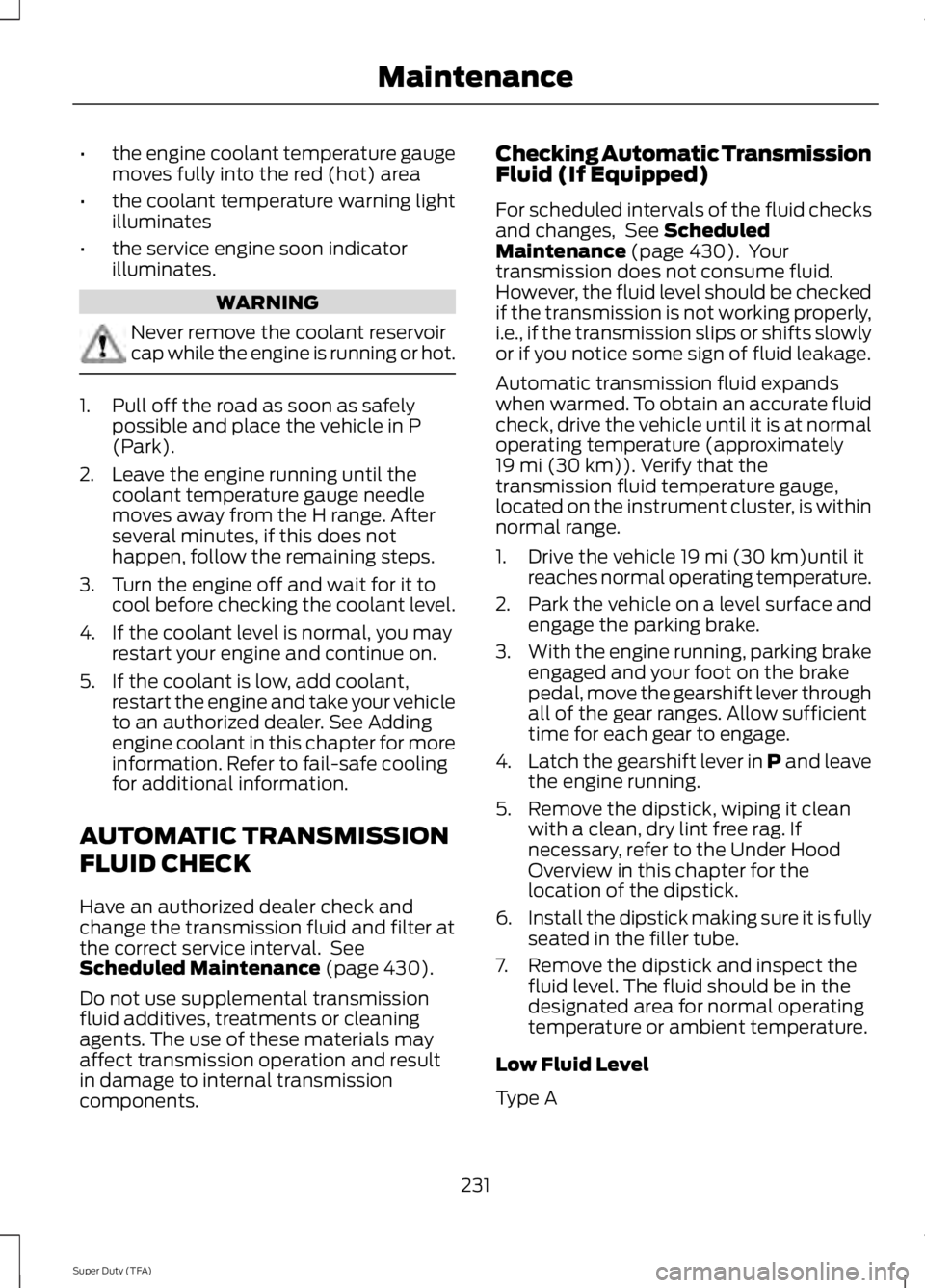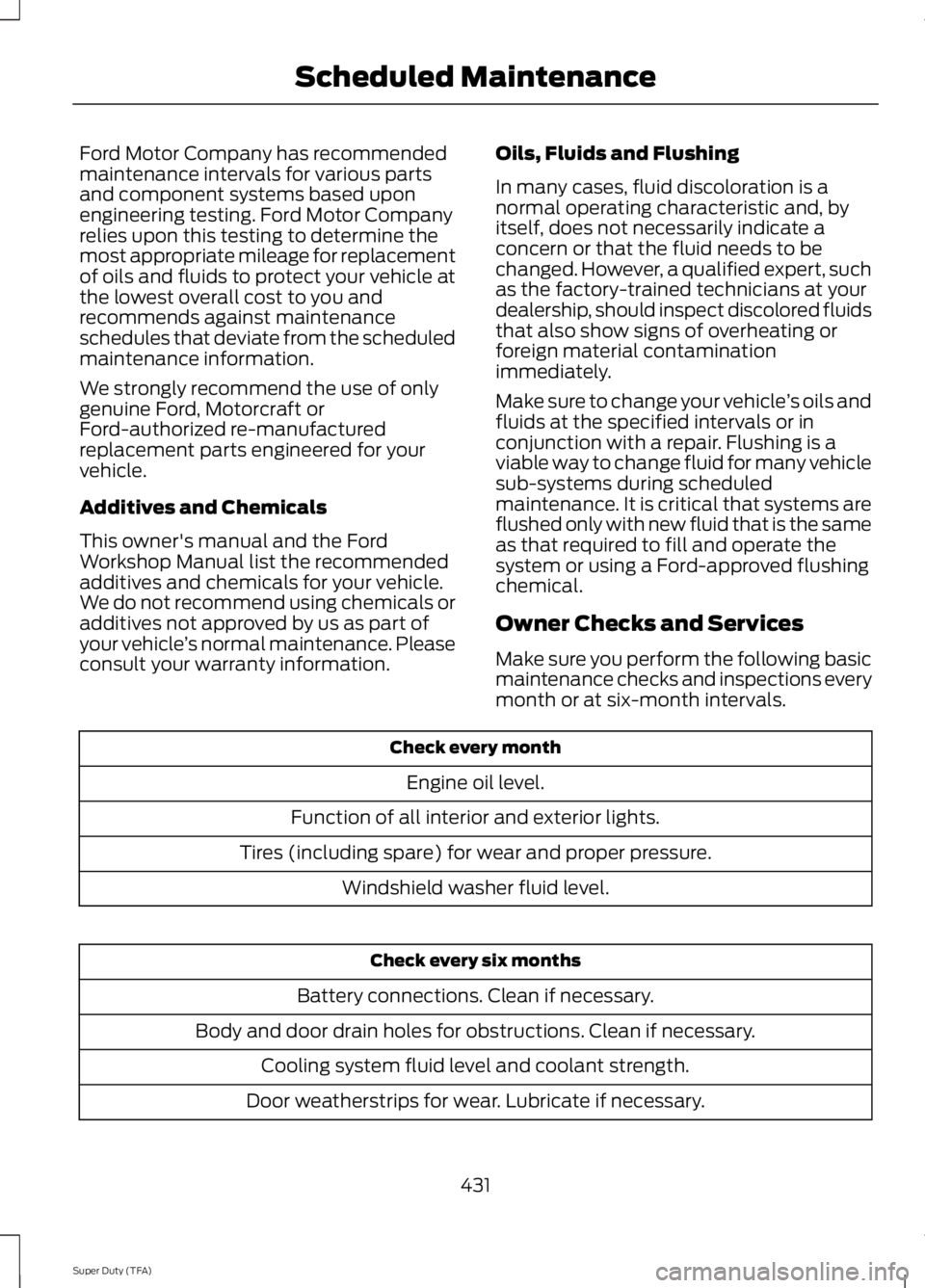2014 FORD F250 SUPER DUTY coolant
[x] Cancel search: coolantPage 234 of 460

•the engine coolant temperature gaugemoves fully into the red (hot) area
•the coolant temperature warning lightilluminates
•the service engine soon indicatorilluminates.
WARNING
Never remove the coolant reservoircap while the engine is running or hot.
1. Pull off the road as soon as safelypossible and place the vehicle in P(Park).
2. Leave the engine running until thecoolant temperature gauge needlemoves away from the H range. Afterseveral minutes, if this does nothappen, follow the remaining steps.
3. Turn the engine off and wait for it tocool before checking the coolant level.
4. If the coolant level is normal, you mayrestart your engine and continue on.
5. If the coolant is low, add coolant,restart the engine and take your vehicleto an authorized dealer. See Addingengine coolant in this chapter for moreinformation. Refer to fail-safe coolingfor additional information.
AUTOMATIC TRANSMISSION
FLUID CHECK
Have an authorized dealer check andchange the transmission fluid and filter atthe correct service interval. SeeScheduled Maintenance (page 430).
Do not use supplemental transmissionfluid additives, treatments or cleaningagents. The use of these materials mayaffect transmission operation and resultin damage to internal transmissioncomponents.
Checking Automatic TransmissionFluid (If Equipped)
For scheduled intervals of the fluid checksand changes, See ScheduledMaintenance (page 430). Yourtransmission does not consume fluid.However, the fluid level should be checkedif the transmission is not working properly,i.e., if the transmission slips or shifts slowlyor if you notice some sign of fluid leakage.
Automatic transmission fluid expandswhen warmed. To obtain an accurate fluidcheck, drive the vehicle until it is at normaloperating temperature (approximately19 mi (30 km)). Verify that thetransmission fluid temperature gauge,located on the instrument cluster, is withinnormal range.
1. Drive the vehicle 19 mi (30 km)until itreaches normal operating temperature.
2.Park the vehicle on a level surface andengage the parking brake.
3.With the engine running, parking brakeengaged and your foot on the brakepedal, move the gearshift lever throughall of the gear ranges. Allow sufficienttime for each gear to engage.
4.Latch the gearshift lever in P and leavethe engine running.
5. Remove the dipstick, wiping it cleanwith a clean, dry lint free rag. Ifnecessary, refer to the Under HoodOverview in this chapter for thelocation of the dipstick.
6.Install the dipstick making sure it is fullyseated in the filler tube.
7. Remove the dipstick and inspect thefluid level. The fluid should be in thedesignated area for normal operatingtemperature or ambient temperature.
Low Fluid Level
Type A
231
Super Duty (TFA)
Maintenance
Page 256 of 460

Fuel system
•Fill the fuel tank with high-quality fueluntil the first automatic shutoff of thefuel pump nozzle.
Cooling system
•Protect against freezing temperatures.
•When removing your vehicle fromstorage, check coolant fluid level.Confirm there are no cooling systemleaks, and fluid is at the recommendedlevel.
Battery
•Check and recharge as necessary. Keepconnections clean.
•If storing your vehicle for more than 30days without recharging the battery, itmay be advisable to disconnect thebattery cables to ensure battery chargeis maintained for quick starting.
Note:If battery cables are disconnected, itwill be necessary to reset memory features.
Brakes
•Make sure brakes and parking brakeare fully released.
Tires
•Maintain recommended air pressure.
Miscellaneous
•Make sure all linkages, cables, leversand pins under your vehicle are coveredwith grease to prevent rust.
•Move vehicles at least 25 feet (8meters) every 15 days to lubricateworking parts and prevent corrosion.
Removing Vehicle From Storage
When your vehicle is ready to come out ofstorage, do the following:
•Wash your vehicle to remove any dirtor grease film build-up on windowsurfaces.
•Check windshield wipers for anydeterioration.
•Check under the hood for any foreignmaterial that may have collectedduring storage (mice/squirrel nests).
•Check the exhaust for any foreignmaterial that may have collectedduring storage.
•Check tire pressures and set tireinflation per the Tire Label.
•Check brake pedal operation. Driveyour vehicle 15 feet (4.5 meters) backand forth to remove rust build-up.
•Check fluid levels (including coolant,oil and gas) to make sure there are noleaks, and fluids are at recommendedlevels.
•If the battery was removed, clean thebattery cable ends and inspect.
Contact your authorized dealer if you haveany concerns or issues.
253
Super Duty (TFA)
Vehicle Care
Page 299 of 460

TECHNICAL SPECIFICATIONS
Ford part number /Ford specificationFord part name orequivalentCapacityItem
XY-80W-90–QL /Motorcraft SAE80W-90 PremiumRear Axle Lubricant
5.8 pints (2.8L)Front axleWSP-M2C197–A
XG-11 /High Temperature4X4 Front Axle andWheel BearingGrease
—Spindle bearingWSS-M1C267-A1
XY-75W140–QL(U.S.) /Motorcraft SAE75W-140 SyntheticRear Axle Lubricant
6.9 pints (3.3L)Rear axle - F-250/350
(10.50 inch axle)1WSL-M2C192-A
CXY-75W140-1L(Canada) /WSL-M2C192-A
XY-75W90–QLS /Motorcraft SAE75W-90 SyntheticRear Axle Lubricant
8.5 pints (4.0L)Rear axle - F-350 (DanaM80)WSS–M2C918–A
XY-75W140–QL(U.S.) /Motorcraft SAE75W-140 SyntheticRear Axle Lubricant
14.0 pints (6.6L)
Rear axle - F-450/550(Dana S110/S130)
WSL-M2C192-A
CXY-75W140-1L(Canada) /WSL-M2C192-A
PM-20 / WSS-M6C65-A1Motorcraft HighPerformance DOT 3LV Motor VehicleBrake Fluid
Between MIN/MAX on brakefluid reservoir
Brake fluid2
PM-20 / WSS-M6C65-A2Motorcraft HighPerformance DOT 4LV Motor VehicleBrake Fluid
VC-3DIL-B (U.S.) /Motorcraft OrangeAntifreeze/CoolantPrediluted
21.3 quarts(20.2L)Engine coolant (6.2L
V8)3WSS-M97B44-D2
CVC-3DIL-B(Canada) /WSS-M97B44-D2
296
Super Duty (TFA)
Capacities and Specifications
Page 300 of 460

Ford part number /Ford specificationFord part name orequivalentCapacityItem
VC-3DIL-B (U.S.) /Motorcraft OrangeAntifreeze/CoolantPrediluted
26.7 quarts(25.3L)Engine coolant (6.8L
V10)3WSS-M97B44-D2
CVC-3DIL-B(Canada) /WSS-M97B44-D2
Refer to the diesel supplement.Engine and fuel coolant(diesel engine)
XO-5W20-QSP orXO-5W20-QFS(U.S.) /
Motorcraft or equi-valent SAE 5W-20motor oil
7.0 quarts (6.6L)Engine oil (6.2L V8 and6.8L V10 gasoline
engines)4,5,6WSS-M2C945-A
CXO-5W20-LSP12 orCXO-5W20-LFS12(Canada) /WSS-M2C945-A
Refer to the diesel supplement.Engine oil (Dieselengines)
——28 gallons(106L)Fuel tank (incompletevehicle, steel tank,middle location)
——35 gallons (132L)Fuel tank (pickup withgasoline engine)
——40 gallons (151L)Fuel tank (incompletevehicle, steel tank, aftaxle location)
Refer to the diesel supplement.Fuel tank (Dieselengines)
Motorcraft XL-5(aerosol) orCRCSL3151ESB /
Multi-PurposeGrease(Lithium grease)
—Hinges, latches, strikerplates and rotors, seattracks, fuel filler doorhinge and springESB-M1C93–B
XL-1 /Motorcraft Penet-rating and LockLubricant
—Lock cylinders—
297
Super Duty (TFA)
Capacities and Specifications
Page 303 of 460

1Add 8 oz. (236 ml) of Additive Friction Modifier XL-3 or equivalent meeting FordSpecification EST-M2C118–A for complete refill of limited slip Ford axles. Ford designrear axles contain a synthetic lubricant that does not require changing unless you submergethe axle in water.2Ford recommends using Motorcraft (Ford) DOT 3 LV High Performance Motor VehicleBrake Fluid, Motorcraft (Ford) DOT 4 LV High Performance Motor Vehicle Brake Fluid orequivalent meeting WSS-M6C65-A1 or WSS-M6C65-A2. Use of any fluid other than therecommended fluid may cause degraded brake performance and not meet the Fordperformance standards. Keep brake fluid clean and dry. Contamination with dirt, water,petroleum products or other materials may result in brake system damage and possiblefailure.3Add the coolant type originally equipped in your vehicle.4Ford has designed your engine to use Motorcraft engine oils or equivalent oils that meetFord’s specification. It is also acceptable to use an engine oil of recommended viscositygrade that meets API SN requirements and displays the API Certification Mark for gasolineengines.5Do not use oils labeled as API SN unless the label also display the API certification mark.These oils do not meet the requirements of your vehicles engine and emissions system.6Do not use supplemental engine oil additives. They are unnecessary and could lead toengine damage not covered by your Ford warranty.7Use the correct automatic transmission fluid. Transmission fluid requirements areindicated on the dipstick blade or the dipstick handle. Check the container to verify thefluid you are adding is of the correct type. Refer to your scheduled maintenance informationto determine the correct service interval.
Note:Automatic transmissions that require MERCON LV should only use MERCON LV fluid.Use of any fluid other than the recommended fluid may cause transmission damage.8Indicates only approximate dry-fill capacity. Some applications may vary based on coolersize and if equipped with an in-tank cooler. You should set the amount of transmissionfluid and fluid level by the indication on the dipstick’s normal operating range.9Fill to the proper capacity according to dipstick Type A. For correct dipstick type, SeeAutomatic Transmission Fluid Check (page 231).9Fill to the proper capacity according to dipstick Type B. For correct dipstick type, SeeAutomatic Transmission Fluid Check (page 231).10See the Warning below:
WARNING
The air conditioning refrigerant system contains refrigerant R-134a under highpressure. Opening the air conditioning refrigerant system can cause personal injury.Have the air conditioning refrigerant system serviced only by qualified personnel.
300
Super Duty (TFA)
Capacities and Specifications
Page 434 of 460

Ford Motor Company has recommendedmaintenance intervals for various partsand component systems based uponengineering testing. Ford Motor Companyrelies upon this testing to determine themost appropriate mileage for replacementof oils and fluids to protect your vehicle atthe lowest overall cost to you andrecommends against maintenanceschedules that deviate from the scheduledmaintenance information.
We strongly recommend the use of onlygenuine Ford, Motorcraft orFord-authorized re-manufacturedreplacement parts engineered for yourvehicle.
Additives and Chemicals
This owner's manual and the FordWorkshop Manual list the recommendedadditives and chemicals for your vehicle.We do not recommend using chemicals oradditives not approved by us as part ofyour vehicle’s normal maintenance. Pleaseconsult your warranty information.
Oils, Fluids and Flushing
In many cases, fluid discoloration is anormal operating characteristic and, byitself, does not necessarily indicate aconcern or that the fluid needs to bechanged. However, a qualified expert, suchas the factory-trained technicians at yourdealership, should inspect discolored fluidsthat also show signs of overheating orforeign material contaminationimmediately.
Make sure to change your vehicle’s oils andfluids at the specified intervals or inconjunction with a repair. Flushing is aviable way to change fluid for many vehiclesub-systems during scheduledmaintenance. It is critical that systems areflushed only with new fluid that is the sameas that required to fill and operate thesystem or using a Ford-approved flushingchemical.
Owner Checks and Services
Make sure you perform the following basicmaintenance checks and inspections everymonth or at six-month intervals.
Check every month
Engine oil level.
Function of all interior and exterior lights.
Tires (including spare) for wear and proper pressure.
Windshield washer fluid level.
Check every six months
Battery connections. Clean if necessary.
Body and door drain holes for obstructions. Clean if necessary.
Cooling system fluid level and coolant strength.
Door weatherstrips for wear. Lubricate if necessary.
431
Super Duty (TFA)
Scheduled Maintenance
Page 435 of 460

Check every six months
Hinges, latches and outside locks for proper operation. Lubricate if necessary.
Parking brake for proper operation.
Safety belts and seat latches for wear and function.
Safety warning lamps (brake, ABS, airbag and safety belt) for operation.
Washer spray and wiper operation. Clean or replace blades as necessary.
Multi-point Inspection
In order to keep your vehicle running right,it is important to have the systems on yourvehicle checked regularly. This can helpidentify potential issues and prevent majorproblems. We recommend having thefollowing multi-point inspection performedat every scheduled maintenance intervalto help make sure your vehicle keepsrunning great.
Multi-point inspection
Horn operationAccessory drive belt(s)
Radiator, cooler, heater and A/C hosesBattery performance
Suspension component for leaks ordamageEngine air filter
Steering and linkageExhaust system
Tires (including spare) for wear and proper
pressure**Exterior lamps and hazard warning systemoperation
Windshield for cracks, chips or pitsFluid levels*; fill if necessary
Washer spray and wiper operationFor oil and fluid leaks
* Brake, coolant recovery reservoir, automatic transmission, power steering and windowwasher.**If your vehicle is equipped with a temporary mobility kit, check the tire sealant expirationUse By date on the canister. Replace as needed.
432
Super Duty (TFA)
Scheduled Maintenance
Page 437 of 460

Other maintenance items
Replace front wheel bearing grease and grease seal if non-sealed bearings are used.
Replace spark plugs.Every 97500 miles (156000km)
Change engine coolant.**
Every 105000 miles(168000 km)Replace rear axle fluid.
Inspect accessory drive belt(s).***
Change automatic transmission fluid and filter on 6-speedtransmission. Consult dealer for requirements.
Every 150000 miles(240000 km)Replace accessory drive belt(s) if not replaced within thelast 100000 miles (160000 km).
Replace front wheel bearings and seals if non-sealedbearings are used.
* If your vehicle has climate-controlled (heated and cooled) seats.** Initial replacement at six years or 105000 miles (168000 kilometers), then every threeyears or 45000 miles (72000 kilometers).*** If not replaced, inspect every 15000 miles (24000 kilometers).
6.7L Diesel Engine
See the diesel supplement for scheduledmaintenance information.
SPECIAL OPERATING
CONDITIONS SCHEDULED
MAINTENANCE
6.2L and 6.8L Gasoline Engines
If you operate your vehicle primarily in anyof the following conditions, you need toperform extra maintenance as indicated.If you operate your vehicle occasionallyunder any of these conditions, it is notnecessary to perform the extramaintenance. For specificrecommendations, see your dealershipservice advisor or technician.
434
Super Duty (TFA)
Scheduled Maintenance